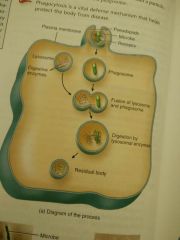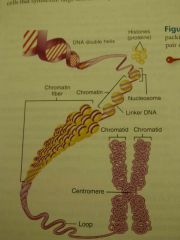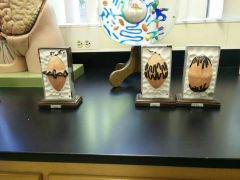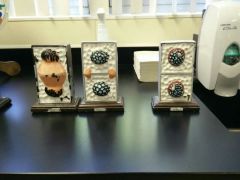![]()
![]()
![]()
Use LEFT and RIGHT arrow keys to navigate between flashcards;
Use UP and DOWN arrow keys to flip the card;
H to show hint;
A reads text to speech;
65 Cards in this Set
- Front
- Back
- 3rd side (hint)
|
Eukaryotic cells
|
Complex cells with nucleus and organelles
|
All fungi plants and animals
|
|
|
3 main parts of a cell include...
|
Plasma membrane (plasmalema)
Cytoplam Nucleus |
|
|
|
Chromosomes
|
Consists of a single molecule of DNA
|
|
|
|
Prokaryotic cells
|
Simple cells with no nucleus
|
Unicellular bacteria
|
|
|
What are common molecules that can/cannot pass through membrane freely
|
Can= H2O, CO2, O2
Cannot = ions and glucose (certain polar substances) |
|
|
|
Ligands
|
Molecules that bind with a receptor
|
|
|
|
Exocytosis
|
Secreting substances outside of cells using vesicular transport
|
Neurotransmitters
|
|
|
Endocytosis
|
Process of moving substances into cells
I. E. Phagocytosis |
|
|
|
Lipid bilayer consists of
|
Phospholipids, cholesterol and glycolipids
|
|
|
|
Integral vs Transmembrane proteins
|
Integral Protiens extend into or through the bilayer
Transmembrane proteins is a type of integral protein. Transmembrane Protiens open to both sides Most integral proteins are transmembrane proteins |
|
|
|
Peripheral proteins
|
Attaches to inner/outer surface but doesn't extend through membrane
|
|
|
|
Glycoprotein
|
Membrane proteins that contain a carbohydrate group. Helps with stabilization and cell identification
|
|
|
|
Glycocalyx; made up off...
|
A sugar coating that sidings entire membrane.
Made up of carbohydrate portions of glycoprotein and glycolipid |
|
|
|
Ion channels
|
Allows passage of specific ions
Just opened and closes like a gate |
Type of membrane protein
|
|
|
Carrier Proteins
|
Carries specific substances by changing its shape
|
|
|
|
Receptor proteins
|
Recognizes specific ligands and alters cells function in some way.
|
|
|
|
Enzymes
|
Catalyzes reactions inside or outside of cells
|
|
|
|
Linker membrane proteins
|
Anchors filaments inside and outside membrane, provides structural stability and shape.
May link 2 cross together too |
|
|
|
Selective permeability
|
Cell membrane allows small, neutrally-charged, lipid-soluble, substances to pass. With the exception of water.
|
|
|
|
List passive processes
|
Diffusion of salutes, Diffusion of solvents (osmosis), facilitated diffusion
|
|
|
|
Facilitated diffusion plus examples
|
Requires a specific channel but passive because it doesn't differently use energy
Carrier mediated (changes shape) Channel mediated (opens and closes like a gate) |
|
|
|
Diffusion
|
Passive spread of particles through random motion
High covenant to low concentration |
|
|
|
2 ways that osmosis can occur are...
|
Through lipid bilayer
*through aquaporins (integral membrane protein) |
|
|
|
Osmotic pressure
|
Amount of pressure you need to apply to get back to starting conditions to reverse the actions of equilibrium.
Osmotic pressure predicts direction of diffusion |
|
|
|
Tonisity
|
Conservation of salt solution in blood an elsewhere
|
|
|
|
What occurs to RBC in a hypertonic condition ?
|
Crenation = movement of water moving out of cell
|
|
|
|
What occurs to a RBC in a hypotonic solution?
|
Hemolysis = inward movement of water resulting in the EXPLOSION of the cell!
|
|
|
|
What pump is found in all cells?
|
The sodium-potassium pump... Duh
|
|
|
|
Antiporters vs symporters
|
Antiporters carries two substances across the membrane but in opposite directions
Symporters carries two substances in he same direction *both examples of secondary active transport |
|
|
|
Secondary active transport
|
Indirectly used energy obtained from hydrolysis of ATP
Uses energy stored in an ionic concentration |
|
|
|
Transcytosis
|
Combination of endocytosis and exocytosis
Moves a substance into, across, and out of a cell |
|
|
|
Phagocytosis
|

Pseudopods, phagosome , fusion of lysosome , digestion, risidual
|
|
|
|
Cytosol
|
Intracellular fluid. Surrounding organelles. Part of cytoplasm; excluding the organelles.
|
|
|
|
Cytoskeleton
|
Network of protein fibers that provides structural support throughout the cytosol .
|
|
|
|
Cytoskeleton types (protein filaments)
|
Microfilaments (outside)
Intermediate filaments (inside) Microtubules (in nucleus) |
|
|
|
Centrosomes
|
Located near nucleus
Contains 2 centrioles and a pericentriolar membrane |
|
|
|
Cillia
|
Short, hairlike , used to move fluids along cell surface
|
|
|
|
Flagella
|
Longer than cilia, moves entire cell, only example = sperms tehe
|
|
|
|
Ribosomes
|
Core of protein synthesis
Composed of large and smaller subunits |
|
|
|
Endoplasmic reticulum
|
Network of membranes
Rough ER = connects to nuclear envelope. Studded with ribosome. Produces various proteins Smooth ER= no ribosomes, synthesizes fatty acids and steroids. Also detoxifies certain drugs |
2 parts
|
|
|
Golgi complex
|
Modified, sorts, and packages packages proteins for transport
Consists of 3-20 flattened sacs called cesteranes |
|
|
|
Lysosomes
|
Vesicles that contain powerful digestive enzymes
|
|
|
|
Peroxisomes
|
Smaller than detoxifies certain toxins such as alcohol
|
|
|
|
Proteasomes
|
Destroys unneeded/damaged/faulty proteins
|
|
|
|
Mitochondria
|
Generates ATP, abundant in physiologically active cells (muscles, kidneys)
|
|
|
|
Cristae
|
Folds in mitochondria
|
|
|
|
Nuclear envelope
|
A double membrane surrounding nucleus
|
|
|
|
Composition of chromosomes
|

|
|
|
|
Transcription vs translation
|
Transcription occurs in the nucleus, RNA polymerase rides along DNA to produce mRNA that corresponds to the genes sequences of DNA (thymine becomes uracil)
Translation occurs in cytoplasm. Ribosomal subunits form around mRNA, tRNA attaches to ribosome at P site then A site based on the anticodon sequence it carries. The tRNA brings an amino acid and a polypeptide bond forms between the two via dehydration synthesis. The tRNA at the p site detaches and cycle repeates till stop codon it reached and polypeptide chain is formed. |
|
|
|
Gene
|
Sequence of nuclotide
|
|
|
|
Human somatic cells contain how many pairs of chromosomes?
|
23 pairs
|
Not total
|
|
|
Homologous chromosomes
|
2 chromosomes that make up each pair.
|
(X)
|
|
|
Diploids vs haploids
|
Haploids have half the number of chromosomes than diploids... (23 vs 46)
Diploids have 2 complete sets while Haploids contain only 1 |
|
|
|
Example of haploids cells
|
Sex cells
|
|
|
|
Interphase
|
Cell spends most of its time in this phase
Cell replicates it's DNA Consists of three phases |
|
|
|
G1 vs S vs G2 phases
|

G1= duplication of organelles
S= Synthesis of DNA (replicated) G2= more cell growth |
|
|
|
Prophase
|

Chromatin fibers change to chromosomes
Nuclear envelope disappears and centrioles start to move to opposite ends |
|
|
|
Metaphase
|

Microtubules align the centromeres of the chromatid pairs @ metaphase plate
*not right 2, just the one on left |
|
|
|
Anaphase
|

Chromatid pairs split @ centromeres and moves to opposite poles of the cell
Characterized by v shape of chromatids Cytokenisis starts in late anaphase along with the formation of the cleavage furrow Chromatids are now called chromosomes *both models on right |
|
|
|
Telophase
|

2 identical nuclei are formed around the the sets of chromosomes (now in their chromatin form )
*last model shows two daughter cells, telephone is models on left |
|
|
|
Mitosis vs meiosis
|
Meiosis is for sex cells (gametes)
MiTOEsis is for cells in ur toes! Lol diploids |
|
|
|
Fertalization
|
Union of 2 gametes
Restores number of chromosomes to 46 |
|
|
|
Meiosis 1
|
Begins with a diploid cellars ends with 2 cells having haploids number of chromosomes
Undergoes PMAT |
|
|
|
Meiosis 2
|
Each of the 2 haploid cells divide to 4 haploid gametes. 4 gametes are genetically different than original diploid starting cell because of genetic recombination
|
|
|
|
4 properties of water
|
Solvent, chemical reaction, high heat capacity, lubrication
|
SCHL
|

